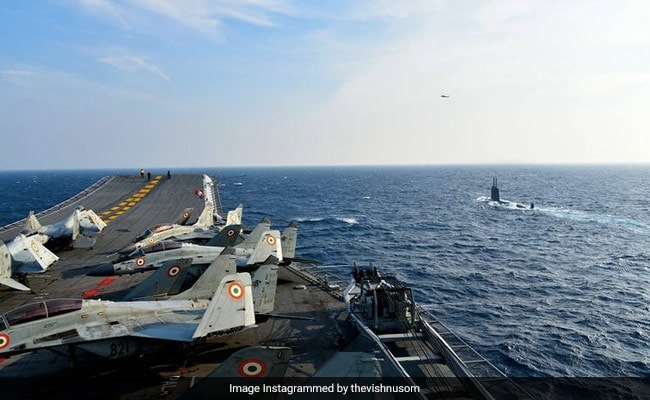
Sources in the Indian Navy have confirmed to NDTV that no signal has been received from the Russian-made emergency locator beacon, which is a key part of the survival kit of the Indian Navy pilot missing in the Arabian Sea for seven days.
Last Thursday, Commander Nishant Singh, an instructor pilot in the Indian Navy, ejected from a twin-seat MiG-29K fighter along with a trainee pilot. While the trainee pilot was immediately rescued by a helicopter, Commander Singh remains missing.
The incident took place shortly after the fighter had taken off from the deck of the Navy's only operational aircraft carrier, the INS Vikramaditya.

When the accident occurred, aircraft carrier INS Vikramaditya was believed to be returning after participating in Malabar naval exercises.
At the moment, the Navy refuses to confirm if the personal locator beacon failed since the matter is under investigation. However, they have confirmed that the unit works only on the surface of the ocean, not if it has sunk.
What is clear is that Commander Singh did eject from the MiG-29K since his ejection seat is missing from the site of the primary wreckage - located at a depth of approximately 100 metres in the Arabian Sea.
''This is a complex case of low-level ejection over the sea,'' say senior Navy sources.
''There are built-in safeties for ensuring that the pilot is separated from the (ejection) seat at an appropriate height and all associated (rescue) equipment is deployed.'' In this case, ''it appears that adequate time was not available for the personal locator beacon to be deployed.''
Designed to start beeping once in contact with sea water, the Russian-built Komar 2(M) unit - in use with the Indian Navy's fighters - has a satellite distress signal transmitter and a short-range homing beacon transmitter. Both are designed to allow rescuers to locate a missing pilot. In addition, a radio transmitter enables a crew in distress to communicate with rescuers. According to RTI, the Russian firm which manufactures the kit, the Komar 2(M) can operate non-stop for 48 hours in positive temperatures.
The Indian Navy has refused to give up search operations in the Arabian Sea though the chances of saving the pilot now appear bleak.
The aircraft carrier INS Vikramaditya was believed to be returning after participating in the high-level Malabar series of Naval exercises with warships from the US, Japan and Australia when the accident occurred.
This is not the first time that India's armed forces have grappled with non-functional, old or obsolete locator beacons installed onboard aircrafts.
Last year, a search and rescue beacon, installed on a missing Indian Air Force An-32 never pinged an SOS signal, as designed, when the aircraft crashed in Arunachal Pradesh with 13 onboard.
In August 2016, the wreckage of another An-32 of the Indian Air Force, with 29 onboard, was never located after it crashed in the Bay of Bengal. There were no distress signals received from emergency locator beacons fitted on that aircraft.
Track Latest News Live on NDTV.com and get news updates from India and around the world

